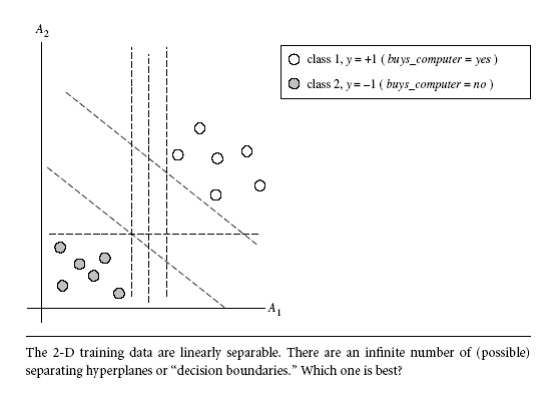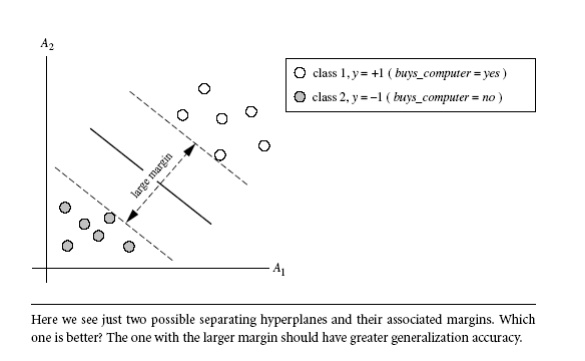Chapter: Data Warehousing and Data Mining : Association Rule Mining and Classification
SVM - Support Vector Machines
SVM—Support Vector Machines
A new classification method for both linear and
nonlinear data
It uses a nonlinear mapping to transform the
original training data into a higher dimension
With the new dimension, it searches for the linear
optimal separating hyperplane (i.e.,
―decision
boundary‖)
With an appropriate nonlinear mapping to a
sufficiently high dimension, data from two classes can always be separated by a
hyperplane
SVM finds
this hyperplane using support vectors (―essential‖ training tuples) and margins
(defined by the support vectors)
Features:
training can be slow but accuracy is high owing to their ability to model
complex nonlinear decision boundaries (margin maximization)
Used both
for classification and prediction
Applications:
handwritten digit recognition, object recognition,
speaker identification, benchmarking time-series prediction tests
1 The Case When the Data Are Linearly Separable
An SVM
approaches this problem by searching for the maximum marginal hyperplane.
Consider the below Figure , which shows two possible separating hyperplanes and
their associated margins. Before we get into the definition of margins, let’s
take an intuitive look at this figure. Both hyperplanes can correctly classify
all of the given data tuples. Intuitively, however, we expect the hyperplane
with the larger margin to be more accurate at classifying future data tuples
than the hyperplane with the smaller margin. This is why (during the learning
or training phase), the SVM searches for the hyperplane with the largest margin,
that is, the maximum marginal hyperplane
(MMH). The associated margin gives the largest separation between classes.
Getting to an informal definition of margin, we can say that the shortest
distance from a hyperplane to one side of its margin is equal to the shortest
distance from the hyperplane to the other side of its margin, where the ―sides‖
of the margin are parallel to the hyperplane. When dealing with the MMH, this
distance is, in fact, the shortest distance from the MMH to the closest
training tuple of either class.



2 The Case When the Data Are Linearly Inseparable
We
learned about linear SVMs for classifying linearly separable data, but what if
the data are not linearly separable no straight line cajn be found that would
separate the classes. The linear SVMs we studied would not be able to find a
feasible solution here. Now what?
The good
news is that the approach described for linear SVMs can be extended to create nonlinear SVMs for the classification of linearly inseparable data (also called nonlinearly separable data, or nonlinear data, for short). Such SVMs
are capable of finding nonlinear decision
boundaries (i.e., nonlinear hypersurfaces) in input space.
“So,” you may
ask, “how can we extend the linear
approach?” We obtain a nonlinear SVM by
extending the approach for linear SVMs as follows. There are two main steps. In
the first step, we transform the original input data into a higher dimensional
space using a nonlinear mapping. Several common nonlinear mappings can be used
in this step, as we will describe further below. Once the data have been
transformed into the new higher space, the second step searches for a linear
separating hyperplane in the new space.We again end up with a quadratic
optimization problem that can be solved using the linear SVM formulation. The
maximal marginal hyperplane found in the new space corresponds to a nonlinear
separating hypersurface in the original space.
Related Topics